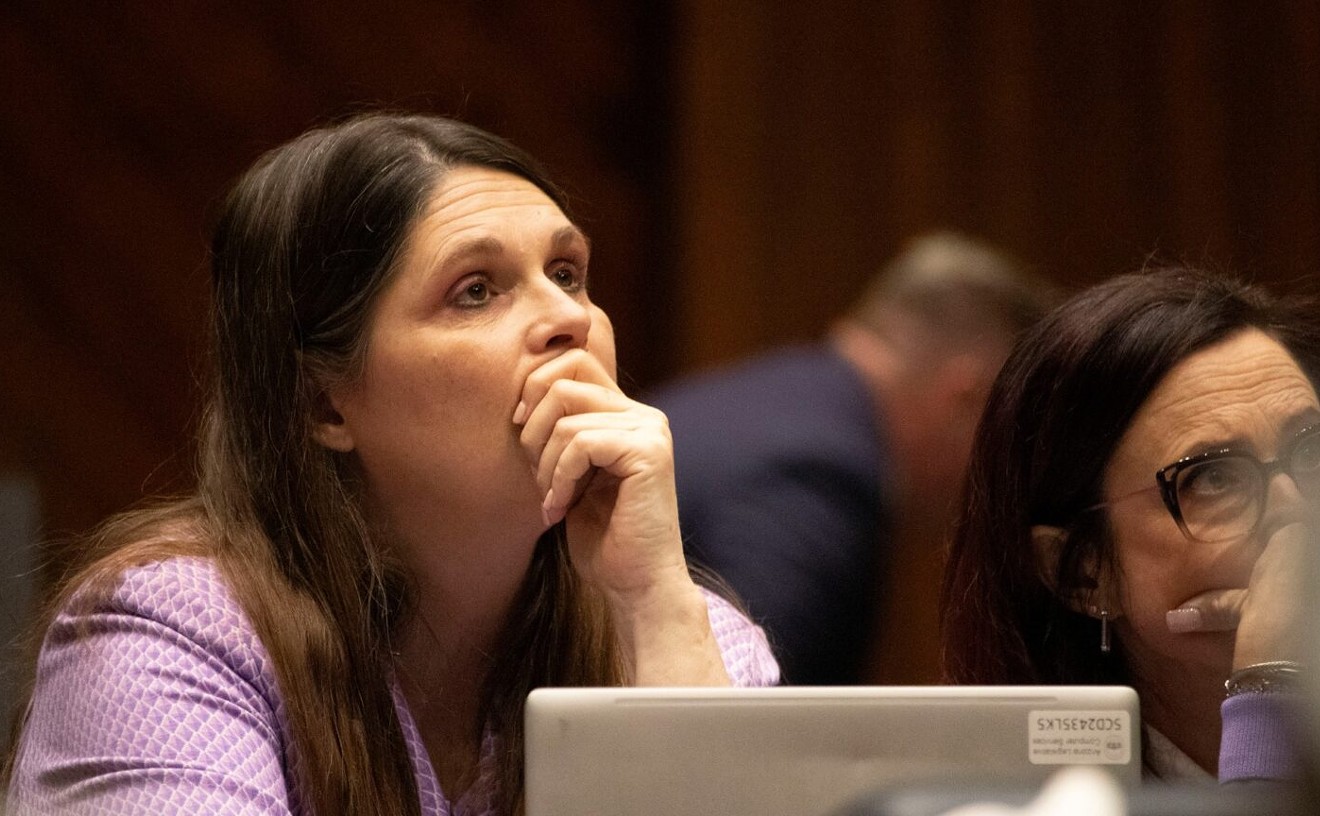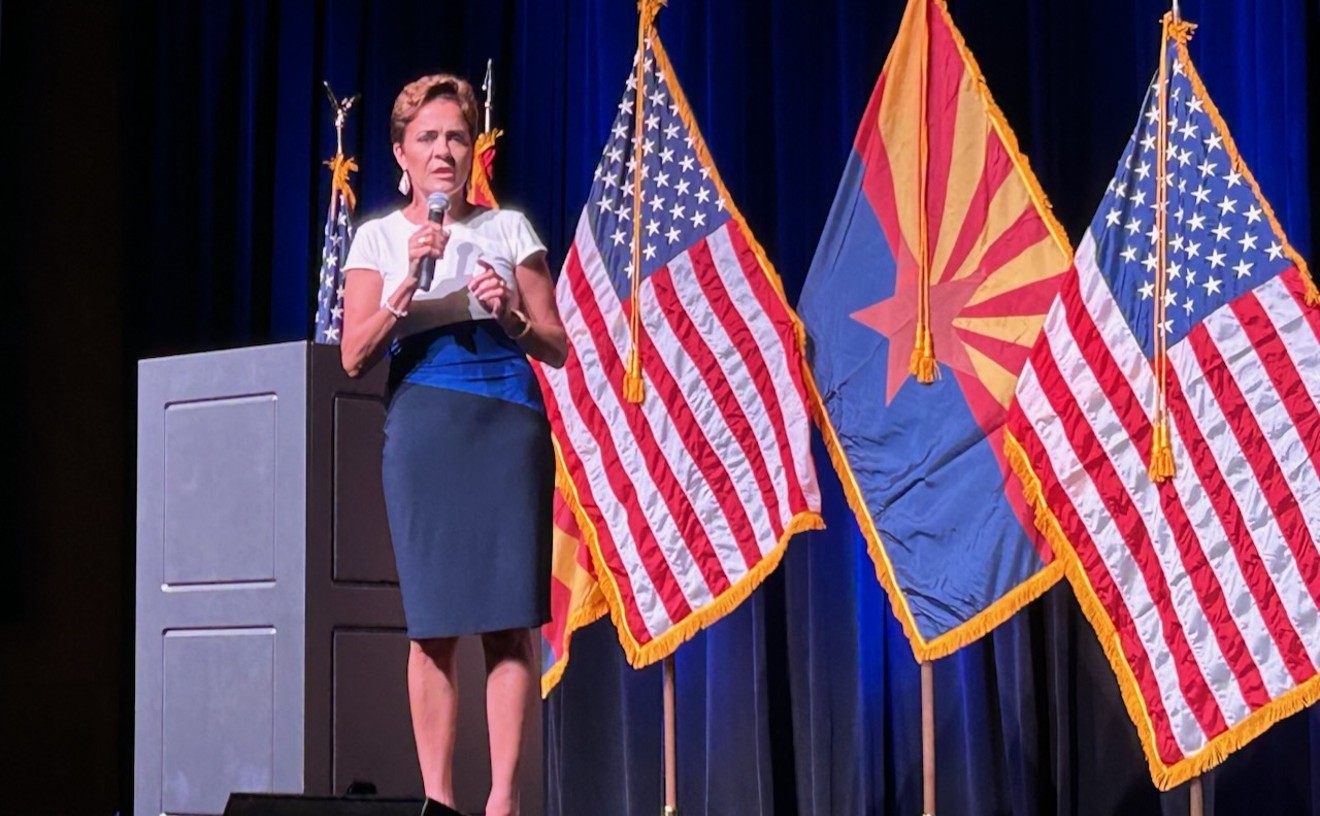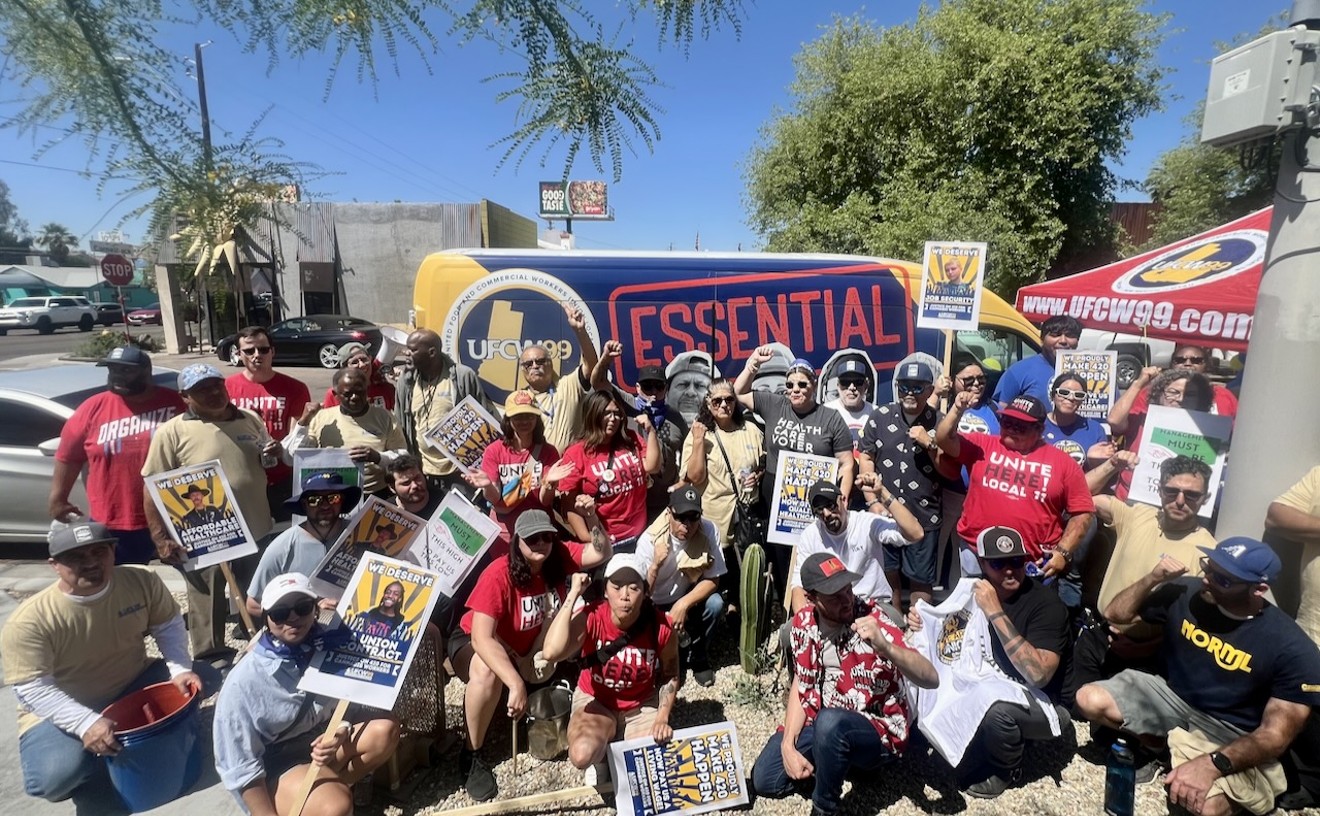In the past half year alone, more than 200,000 people passed through the Norman Rockwell exhibition at the Phoenix Art Museum. Another 19,000 took in the James Turrell show at the Scottsdale Museum of Contemporary Art.
Last year, ASU's performing arts series at Gammage Auditorium claimed more than 244,000; the Scottsdale Center for the Arts, another 160,000. And the Phoenix Symphony, Arizona Opera and Ballet Arizona combined to lower some 400,000 viewers into the grave of numbers that have come to define our cultural success.
According to the Arizona Commission on the Arts, more than six million people attended commission-sponsored arts events or institutions last year. That's up from about four million a decade ago.
Less might be more when it comes to aesthetics. But at the box office and on the bottom lines of arts organizations, size matters more than it ever has.
You don't have to be a grant writer to understand why.
Larger audiences translate into cash. The more money that arts organizations earn at the gate, the less they need to raise by passing the nonprofit hat.
In the performing arts, packed houses, like filled sports stadiums, can heighten performances and instill a seat-edge thrill that half-empty halls cannot.
That isn't the case at museums, where empty galleries are bliss -- a quiet encounter between you and the art. But such solo viewing is a pleasure that few institutions feel they can encourage or afford. Blockbusters are the proven way to attract an increasingly distracted public. The resulting throngs help to justify the millions of dollars that local governments, corporations and foundations pour annually into the arts. And they assure financial backers that the civilizing benefits of culture -- along with the patrons' good names and deeds -- are reaching the masses.
The ASU Art Museum drew 60,000 last year, Actors Theatre of Phoenix 29,000, and the Heard Museum 250,000 more.
Like other younger American cities, Phoenix for years has painted its cultural worth by the numbers. Before the Diamondbacks -- 2.9 million last year, down from their opening-year high of 3.6 million -- arrived, cultural leaders bragged that more people took in arts than sports here. They boasted that Scottsdale's art market, which annually moves airport tons of tourist tchotchkes, was among the nation's top cultural emporia.
The new and expanded museums and theaters built here in the past decade have unquestionably widened public access to art and diversified the palette of cultural offerings.
At the community level, art classes and workshops, through nonprofit organizations and municipal recreation programs, have expanded significantly in some cities, helping to fill the educational void left by dramatic declines of scholastic arts programs.
But venues for serious art remain relatively limited here. Some are continually on the financial brink. For almost five months out of the year, classical forms of music and dance dry up and much of the Valley's theater blows away. And modern and contemporary arts continue to terrify board members of institutions that should be the Valley's chief advocates of pioneering works.
The truth about the numbers is that they are a side show of limited relevance to the health of local culture. And most arts leaders know that.
"The numbers are a reflection of something," says Shelly Cohn, executive director of the Arizona Commission on the Arts, "but they've not always reflected what the arts are about."
Attendance stats say nothing about the experience or quality of the art being presented or produced, what people think and feel about it, or what arts organizations are doing to deepen the meaning of participating in culture.
"Selling a lot of tickets doesn't necessarily mean you're a good organization," says Barbara Meyerson, executive director of the Arizona Museum for Youth. "It might mean only that you're a good salesperson, or that you've spent enough money on the right kind of marketing to get people to come see you. The real questions should be, 'What are people taking home with them? Are they learning? Are they growing in some way that they wouldn't without having gone? And are they coming back?'"
These questions occupy the core of just about every nonprofit arts organization's stated mission. Yet they aren't easily answered by the kinds of numbers that most arts organizations have been gathering.
The problem is that data collection in the arts, here and nationally, has traditionally followed the money.
Cultural nonprofits have tracked only the numbers they needed to build their cases for requesting increased government and philanthropic support.
"We probably need to divorce our data-collecting from the language of money," says Kelly Barsdate, director of research at the National Association of State Arts Agencies.
The current numbers, she says, not only "haven't told us what the meaning of arts participation is. They haven't told arts organizations how they can shape that participation, or how they can make decisions differently in order to really connect with the experience of their patrons."
That may be changing.
A decade ago, says Barsdate, the main question was how much money you spent. "Then it turned into, 'Tell me how much money you spent and how many people showed up. Were they old? Were they people of color?' Threaded throughout there is the interest in access and distribution. Is it an urban constituency? Is it a rural constituency? Is it a low-income population? Now I think people are starting to say, okay, the money is fine, people are showing up. We know who's showing up. But what happened when they got there?"
That last question represents the new frontier of cultural data mongering: a long-overdue attempt to uncover the qualitative factors that bring people to the arts.
The new data trails are being blazed by a number of key philanthropic foundations. In recent years, the Heinz Foundation, in Pittsburgh, which has invested millions of dollars to help arts organizations build programming and audiences, funded a landmark study about the fundamental lure of metaphor.
This summer, the Lila Wallace Reader's Digest Foundation will release a study -- commissioned from the Rand Corporation -- about the meanings and motives underlying cultural participation.
The study evolved from the foundation's well-publicized efforts to expand arts audiences in the past decade. During the 1990s, the organization poured some $300 million into raising arts attendance across the country.
Midway through that effort, it concluded that arts participation meant a good deal more than simply counting heads.
"The realization," says Michael Moore, director of the foundation's art program, "was that there was a commonality to successful arts organizations across the country. And this was true with organizations producing different kinds of art."
Their success wasn't one-dimensional, Moore says. Thriving institutions managed a consistent balance of artistic excellence and financial stability. "And as a result, they enjoyed higher prestige and support from their communities."
Wallace is building upon the Rand findings by funding 13 state arts agencies around the nation with five-year, $500,000 grants to develop qualitative tools to assess local arts programming.
The Arizona Commission on the Arts is one of 13 agencies receiving the grant.
Shelly Cohn says the agency is still discussing how the money will be used.
"We know we need to find a better way to measure the quality of what we do," she says. "We need to understand what these numbers mean, so we can make the case in a public and policy way what the value of the arts is. We haven't been as systematic, thoughtful and strategic about that as we could be, and, until now, we haven't had the resources to understand the data."
The search for qualitative data is hardly new or confined to the art world.
"Businesses and corporations have typically included a lot of this kind of information in their work," says Jerry Yoshitomi, a national arts consultant and former assistant director of the Arizona Commission on the Arts. "And they're using it to compete against nonprofits for leisure dollars and leisure time.
"I wouldn't call it marketing. On the commercial side, you understand the consumer to the point where he helps shape the product. If you think that customers want a different kind of tie, you stock a different kind of tie. Marketing in the arts is different. You tend to say that this is the ballet we've chosen to do this year. Then you figure out who you're going to sell it to."
For years, selling well in the arts connoted selling out.
"There's almost this perverse sense in the arts," says Becky Gaspar, director of Arizonans for Cultural Development, "that says if something's popular and everybody's doing it, it must not be challenging or cutting edge or terribly insightful."
As a result, arts organizations here and elsewhere have been exceedingly slow to understand and embrace marketing as a business tool. But fierce competition for audience attention and the rising costs of professionalization in the arts have made marketing essential. Unfortunately, too few arts organizations here have had the wherewithal to make it a regular part of their programming.
The Phoenix Art Museum has invested heavily in marketing in recent years, significantly raising its advertising budgets and conducting fairly sophisticated attitude and exit surveys to determine the level of public awareness about the museum and how well viewers like its blockbuster exhibitions.
"You have to have a certain level of advertising to be effective," says Tony Basche, who heads the museum's marketing program. "In combination with sponsors, if we can, in a given year, develop an advertising budget of about three-quarters of a million dollars, we can have a significant impact. But as you drop down from that, you really lose impact pretty quickly."
The ad firm Cramer-Krasselt has been developing a comprehensive marketing program for the Phoenix Symphony. And ASU's public events program, which runs Gammage Auditorium, has been working with Jerry Yoshitomi to better understand its audiences.
Smaller organizations, with bootstrap budgets, have had to rely instead on press releases, word of mouth and chance media coverage to catch the public's eye.
That isn't easy to do in a market dominated occasionally by blockbusters, such as Norman Rockwell, Monet or The Phantom of the Opera.
Nor is it easy given the frenzied demand on leisure time. There's a sense, and not just in the arts, that the multiple distractions of modern life are devouring the free time people have to attend anything cultural.
Another looming concern is that audiences have not kept up with population growth.
"There's a great fear," says Yoshitomi, "that the number of cultural subscribers is aging and declining.
"The attendance of art audiences drops precipitously when people reach their 70s. And the younger generation, the boomer generation, are not attending the arts in the numbers or as actively as their parents did. They're also tending toward a broader array of things. They're omnivores. They're going to see Broadway, Springsteen, the Stones concert, the Diamondbacks. But they're not necessarily buying subscriptions to the symphony."
Joan Squires, president of the Phoenix Symphony, says the aging audience is driving orchestras and other performing organizations to find ways to reach families and younger people with more diversified programming.
To do that, they've added more performance times and broadened their programming to include music ranging from pops to classical.
With help from their ad firm, they've also done some in-depth focus groups, to better grasp why people are coming and not coming.
Not surprisingly, they've found that the powerful emotions aroused by live, symphonic music is a chief draw for many listeners.
Yet the focus sessions also uncovered some significant perceptual barriers that discouraged people from attending.
"One of the guys said, 'I can't go to the symphony because I drive a Jeep, not a Lexus,'" says Cyndi Suttle, the symphony's director of marketing. "So we said, 'Time out, here. That's a myth.'"
The other stereotype is that everybody wears tuxedos.
"The obstacle we have to overcome," she says, "is that this is elitist."
The ad campaign produced by Cramer-Krasselt tackles that with romance.
One ad shows a couple on the outs at a breakfast table. The gal's reading a newspaper and not talking. The guy's feeling her wrath.
"Dinner and a movie won't fix this one," runs the tag line.
A second ad features a couple returning from a night out. The woman leans into the man for a passionate kiss.
Tag line: "When's the last time three hours of football put her in the mood?"
Not long after the ad began running, a young man called the box office.
"I've seen your ad campaign," he told the attendant. "I'm bringing a girl here. So I'm counting on this being a great experience."
This hunger to have a great experience, to be moved, or to feel, see or convey something unique has long been the driving force and attraction of the arts.
In an age shaped increasingly by the homogenizing pressures of mass production and marketing -- same products in every store, same landscapes along every street, same movies and channels and ads on every screen -- the arts remain one of the few arenas of contemplative individuality.
That basic asset is too often forgotten when arts organizations, in the scuffle for crowds, insist on measuring success by the numbers.
By blockbuster standards, 19,000 -- the attendance at the James Turrell exhibition at the Scottsdale Museum of Contemporary Art -- is a puny number. Yet the show represents an enormous cultural return on its financial investment. It features works not commonly seen -- works that significantly deepen the well of available culture. The ASU Art Museum, which typically draws far fewer people in a year than the Phoenix Art Museum did with the Rockwell show, has also carved a valuable niche with innovative programming.
If the arts are to thrive and grow into the elaborate institutions being built for them here, cultural organizations and funders will need to raise their sights above the bottom lines and distinguish between good art and good business.
Too often, funders and boards have viewed accountability strictly through a fiscal lens, imposing foolish requirements on the art organizations to predict the unforeseeable.
"So when the Acme Corporation says they'll give you $20,000 this year," says Matthew Wiener, artistic director of Actors Theatre of Phoenix, "they want to know not just what are you going to do with it, but how are you going to measure it? How are you going to prove that you're holding up your end of the bargain? Saying that we're going to produce really good theater this year isn't enough anymore."
But that should be enough.
"We're really in the meaning business," says Jerry Yoshitomi.
Finding that meaning in the numbers is the stumper.










